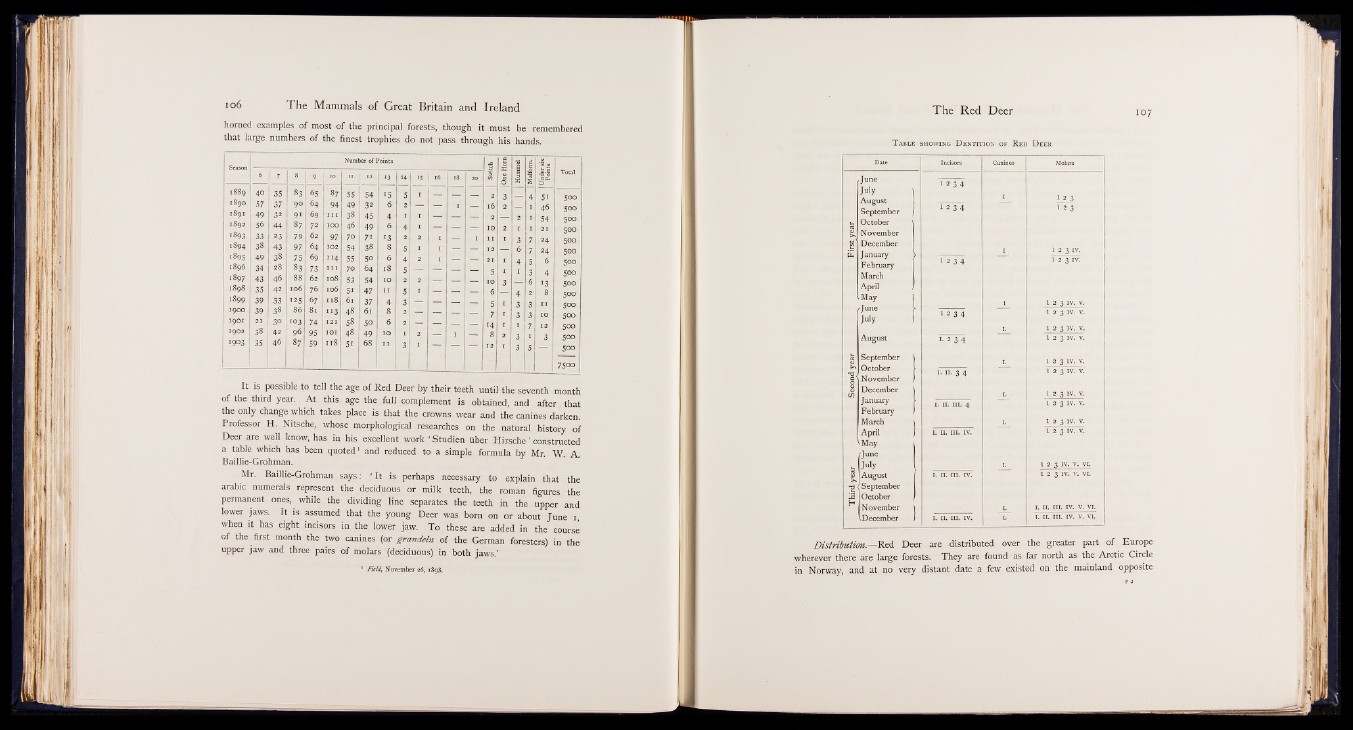
horned example^, of most of the principal forests, though it must be remembered
that large numbers of the finest trophies do not pass through his hands.
Number of Points
6 7 8 9 . ,0 » .* 13 14
I8 8 9 40 35 83 65 87 55 54 15 5
O 0O0n
57 37 9 0 64 94 49 32 6 2
189I 49 32 91 69 h i ,38-. 45 4 I
1892 56 44 87 72 100 46 49 6 4
I893 33 23 79 62 97 70 71 13 2
1894 ,38 43 97 64 102 54 38 8 5
189s 49 38 75 69 114 55 50 6 4
I8 9 6 34 28 83 73 h i 79 64 18 5 1897 43 46 88 62 108 53 54 10 2
1898 35 42 106 76 106 51 47 i l 5
1899 39 33 * 25 67 118 61 37 4 3 I9OO 39 38 86 81 ” 3 48 61 8 2
I9O I 21 30 103 74 121 58 50 6 2
I9O2 38 42 96 95 IOI 48 49 10 i
I9O3 35 46 87 59 118 51 68 i l 3
.g g 8 g » a
I T‘6 18 » m 0
1
X £ BO, Total
I -3 - - 2 3 1 4 SI 50O 1 — 16 2 — I 46 5OO
— — 2 — 2 1 54 SCO — IO 2 1 21 5OO
I I 11 I 3 7 24 5 00
I - — 12 — 6 7 24 5OO
I — 21 I 4 5 6 5 00 — ~~ 5 1 ' y 3 4 50O — 10 3 S 6 13 5 00
' ~ ~ 6 — 4 2 8 500 — — 5 1 3 3 i l 5OO
7 I 3 3 10 5OO
— — 14 1 1 7 12 5OO — 1 8 2 3 I 3 5OO
— 12 V1 3 5 — 5OO
7 50 0
It is, possibly Jp jtell the age of Red Deer by their teeth until the seventh month
of the third year. At this age the full complement is obtained, and after that
the only change which takes place is that the crowns wear and the canines darken.
Professor H. Nitsche, whose morphological researches on the natural history of
Deer are well know, has in his excellent work ‘ Studien über Hirsche’ constructed
a table which has been quoted1 and reduced to a simple formula by Mr. W. A
Baillie-Grohman.
Mr. Baillie-Grohman says: ‘ It is perhaps necessary to explain that the
arabic numerals represent the deciduous or milk teeth, the roman figures the
permanent one?,. while the dividing line separates the teeth in the upper and
lower jaws. It is assumed that the young Deer was born on or about June i,
when it has eight incisors in the lower jaw. To these are added in the course
of the first month the two canines (or grandeln o f the German foresters) in the
upper jaw and three pairs of molars (deciduous) in both jaws.’
1 Field, November 26, 1898.
T a b le showing D en t it io n o f R ed D eer
Date ■ I»c«o„ Canines Molars
June 1 2 3,4 "
July
August I I 2 3
September
u October
V November
« I December
January
February
I , 1 2 3 iv.
1 2 3 4 1 2 3 IV.
March
April
May
June
l , 1 2 3 IV, V.
1 2 3 4 1 2 3 IV. V.
July
I. 1 2 3 IV. V.
August I- 2 3 4 • 1 1 i 2 3 IV. V.
ctS September 1 2 3 IV. V.
H October I. il. 3 4 1 2 3 IV. V.
c N ovember
co
December
January
I. I 2 3 IV. V.
I. il h i. 4 1 2 3 IV. V.
February
March I. 1 2 3 IV. V.
April I. II. III. IV. 1 2 3 IV. V.
^May
/■ June
s July 1 2 3 IV. V. VI.
V August I. II. III. IV. 1 2 3 IV. V. VI.
’S September
Ip October
November I. I. II. III. IV. V. VI.
\December I. II. III. IV. I. I. II. III. IV. V. VI.
Distribution.— Red Deer are distributed over the greater part of Europe
wherever there are large forests. They are found as far north as the Arctic Circle
in Norway, and at no very distant date a few existed on the mainland opposite